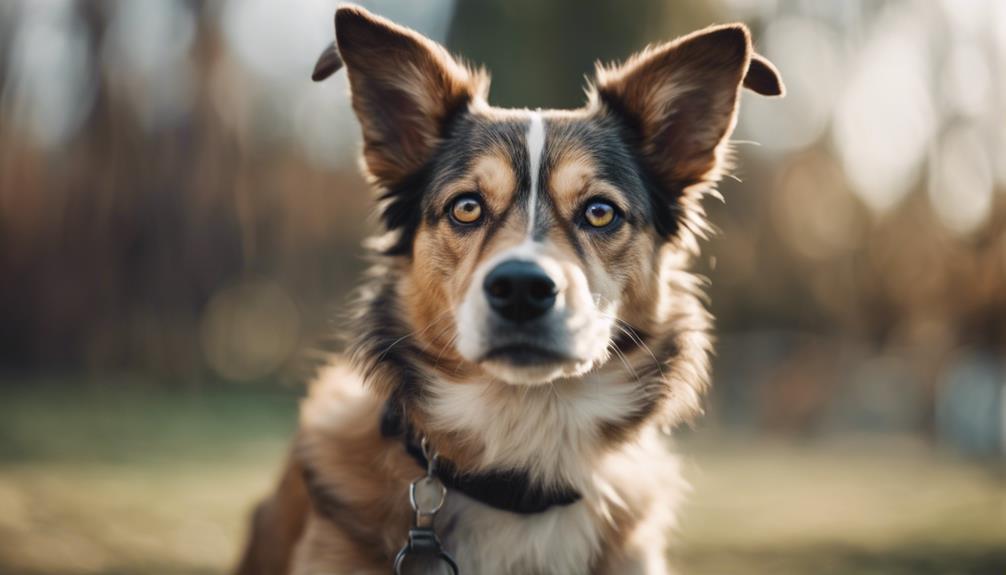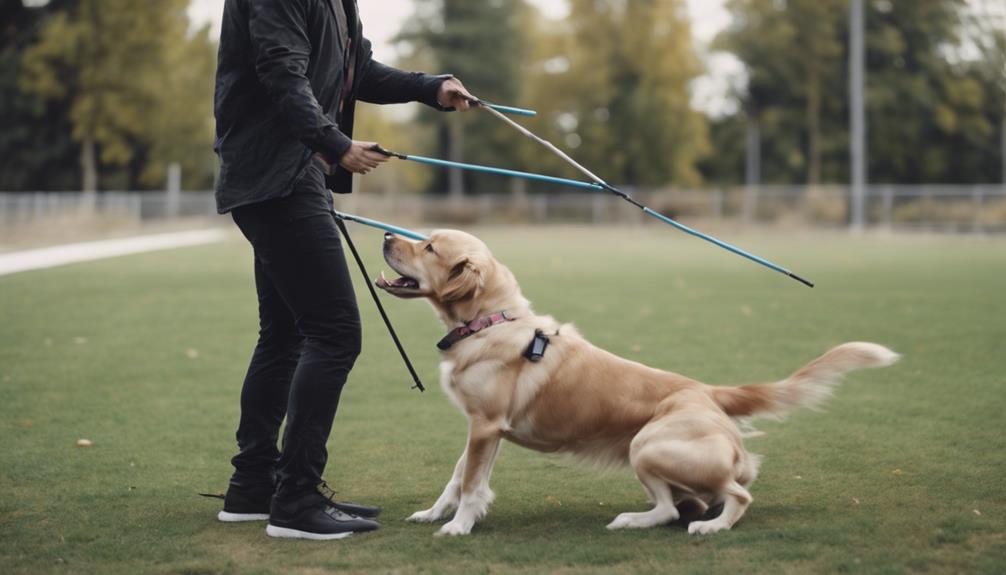One in every three dog breeds is known for having a strong prey drive, a trait that can significantly impact their behavior and interactions with their human companions.
When a dog exhibits a robust prey drive, it goes beyond a simple interest in chasing squirrels at the park. Understanding the implications of this instinctual behavior is vital for owners looking to establish a harmonious relationship with their canine friends.
By exploring the nuances of a dog's prey drive and its effects on daily interactions, owners can gain valuable insights into their pet's needs and behaviors, paving the way for a more fulfilling and well-balanced companionship.
Key Takeaways
- Dogs with strong prey drive have an innate desire to pursue and catch prey.
- Recognizing signs of intense focus, stalking, and chasing indicates a high prey drive.
- Training and supervision can help manage and redirect a dog's prey drive effectively.
- Understanding and addressing prey drive behaviors early can foster a harmonious relationship with the dog.
Definition and Significance
Understanding a dog's prey drive is crucial for pet owners to navigate their canine companion's behavior effectively. Prey drive refers to a dog's natural instinct and eagerness to search for, pursue, and capture prey. This innate behavior is often more pronounced in breeds that were historically used for hunting or herding tasks.
Dogs with a high prey drive may exhibit behaviors such as intense focus, stalking, chasing, and pouncing. Recognizing these signs can help owners tailor training and management strategies to redirect this drive towards appropriate outlets. By acknowledging and addressing a dog's prey drive, pet owners can create a safe and enriching environment that allows their furry friend to thrive while maintaining control over their hunting instincts.
Breeds Prone to Prey Drive
Breeds with a high prey drive are often characterized by their strong hunting instincts and inclination towards pursuing and capturing prey. Some breeds known for their pronounced prey drive include:
- Siberian Husky
- Jack Russell Terrier
- Australian Cattle Dog
- Belgian Malinois
- Weimaraner
Behavioral Indicators of Prey Drive

Behavioral indicators of prey drive often manifest through a dog's intense focus and physical readiness to pursue potential prey. Dogs with a strong prey drive may exhibit behaviors such as fixation on moving objects, quick movements, and an eagerness to chase or capture prey-like items.
They might display stalking behaviors, such as crouching low to the ground, maintaining a fixed gaze, and moving stealthily towards a target. Additionally, dogs with a high prey drive may demonstrate heightened excitement or arousal when presented with stimuli that trigger their hunting instincts.
These behavioral cues can help owners identify and understand their dog's natural drive to hunt and capture prey, allowing for appropriate training and management strategies to be implemented.
Understanding Canine Body Language
As dogs with a high prey drive exhibit specific behavioral indicators, it's crucial for owners to recognize and interpret their canine companions' body language cues effectively. Understanding canine body language can provide valuable insights into a dog's prey drive intensity and behavior.
Here are five key body language cues to look out for:
- Heightened alertness
- Forward ears
- Fixed eyes
- Poised body posture
- Tense or focused facial expression
Training Techniques for Prey Drive

To effectively address a dog's prey drive through training, owners can implement interactive play and positive reinforcement techniques. Interactive play sessions using toys that mimic prey can redirect the dog's instincts in a controlled environment. Positive reinforcement, such as treats or praise, should be given when the dog engages in appropriate play and ignores undesired behaviors.
Consistency is key to reinforcing the desired responses and discouraging unwanted actions. Training sessions that focus on obedience and impulse control can also help manage a dog's prey drive. It's important to be patient and understanding during the training process, as modifying ingrained behaviors takes time and effort.
Seeking guidance from professional trainers can provide additional support and expertise in addressing prey drive effectively.
Environmental Management Strategies
Owners can effectively manage a dog's prey drive through strategic environmental adjustments within their living spaces. By making specific changes to the environment, owners can help redirect their dog's prey drive in a positive direction and prevent unwanted behaviors. Here are five key environmental management strategies:
- Secure Fencing: Installing secure fencing in the yard can prevent dogs with strong prey drive from escaping and chasing wildlife.
- Indoor Enrichment: Providing interactive toys and engaging activities indoors can help satisfy the dog's hunting instincts.
- Limiting Exposure: Minimizing exposure to stimuli that trigger prey drive, such as keeping curtains closed to prevent visual distractions.
- Supervised Outdoor Time: Ensuring dogs with high prey drive are always supervised during outdoor activities to prevent chasing behaviors.
- Creating Safe Zones: Designating certain areas in the home where the dog can relax and feel secure, away from potential triggers.
Professional Support and Guidance

Seeking guidance from trained professionals can significantly aid in effectively managing and modifying a dog's prey drive behaviors. Professional support is crucial for understanding the intricacies of a dog's prey drive and implementing tailored training strategies.
Behaviorists and trainers possess the expertise to assess the dog's behavior, identify triggers, and develop personalized plans to address excessive prey drive. They can provide valuable insights on how to redirect the dog's instincts towards more appropriate outlets, such as engaging toys or structured activities.
Moreover, these professionals can offer guidance on using positive reinforcement techniques to reinforce desired behaviors and discourage hunting tendencies. By seeking professional support and guidance, dog owners can navigate the challenges associated with strong prey drive and cultivate a harmonious relationship with their canine companions.
Implications on Owner-Dog Relationship
Understanding the impact of a dog's prey drive on their owner-dog relationship is crucial for fostering a harmonious bond based on mutual understanding and effective communication. Dogs with strong prey drive can present unique challenges and considerations for owners, such as:
- Training Adaptation: Owners may need to tailor training methods to redirect prey drive behaviors effectively.
- Exercise Requirements: Meeting the physical and mental stimulation needs of a high prey drive dog is essential for their well-being.
- Environmental Management: Ensuring a safe environment with secure boundaries to prevent chasing behaviors.
- Behavioral Awareness: Recognizing and addressing signs of prey drive to avoid conflicts or accidents.
- Professional Guidance: Seeking assistance from trainers or behaviorists can provide valuable support in managing prey drive tendencies.
References and Further Reading

Having a solid understanding of reliable references and further reading materials is essential for gaining in-depth insights into managing a dog's prey drive effectively. When looking for additional resources on dog behavior and prey instincts, pet owners can explore reputable sources such as books by renowned animal behaviorists like Patricia McConnell or Karen Pryor.
Websites like the American Kennel Club (AKC) and the Association of Professional Dog Trainers (APDT) offer valuable articles and training tips specifically addressing prey drive in dogs.
Scientific journals like the Journal of Applied Animal Behavior Science can provide in-depth research on canine behavior and prey-related topics. By delving into these references, dog owners can enhance their knowledge and develop effective strategies for handling and training dogs with a strong prey drive.
Conclusion
In conclusion, understanding and addressing a dog's strong prey drive is essential for fostering a healthy relationship between owners and their canine companions.
By recognizing the signs of prey drive, implementing appropriate training techniques, and providing mental stimulation, owners can effectively manage and redirect their dog's instincts towards positive outlets.
With proper guidance and support, owners can cultivate a balanced companionship based on mutual respect and understanding, ensuring a harmonious coexistence with their furry friends.




